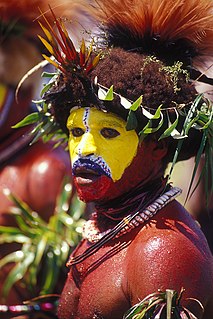 W
WThe Abelam are a people who live in East Sepik Province of Papua New Guinea. They are a farming society in which giant yams play a significant role. They live in the Prince Alexander Mountains near the north coast of the island. Their language belongs to the Sepik language family.
 W
WThe Angu or Änga people, also called Kukukuku are a small and previously violent and cannibal group speaking a number of related languages and living mainly in the high, mountainous region of south-western Morobe, a province of Papua New Guinea. Even though they are a short people, often less than 5 foot, they were feared for their violent raids on more peaceful villages living in lower valleys.
 W
WThe Baining people are among the earliest and original inhabitants of the Gazelle Peninsula of East New Britain, Papua New Guinea. They currently inhabit the Baining Mountains into where they are thought to have been driven by the Tolai tribes who migrated to the coastal areas in comparatively recent times. Another factor that might have influenced their migration inland was major volcanic activity that took place over centuries.
 W
WThe Huli are an indigenous people who live in the Hela Province of Papua New Guinea. They speak primarily Huli and Tok Pisin; many also speak some of the surrounding languages, and some also speak English. They are one of the largest cultural groups in Papua New Guinea, numbering over 250,000 people.
 W
WThe Iatmul are a large ethnic group of about 10,000 people inhabiting some two-dozen politically autonomous villages along the middle Sepik River in Papua New Guinea. The communities are roughly grouped according to dialect of the Iatmül language as well as sociocultural affinities. The Iatmul are best known for their art, men's houses, male initiation, elaborate totemic systems, and a famous ritual called naven, first studied by Gregory Bateson in the 1930s. More recently, Iatmul are known as a location for tourists and adventure travellers, and a prominent role in the 1988 documentary film Cannibal Tours.
 W
WThe Kaluli are a clan of non-literate indigenous peoples who live in the rain forests of the Great Papuan Plateau in Papua New Guinea. The Kaluli, who numbered approximately 2,000 people in 1987, are the most numerous and well documented by post-contact ethnographers and missionaries among the four language-clans of Bosavi kalu that speak non-Austronesian languages. Their numbers are thought to have declined precipitously following post-contact disease epidemics in the 1940s, and have not rebounded due to high infant mortality rates and periodic influenza outbreaks. The Kaluli are mostly monolingual in an ergative language.
 W
WThe Kwoma are a people of northeastern New Guinea who live in the Peilungupo mountains north of the Sepik River. They speak the Kwoma language.
 W
WMelanesians are the predominant and indigenous inhabitants of Melanesia, in a wide area from the Maluku Islands,East Nusa Tengarra and New Guinea to as far east as the islands of Vanuatu and Fiji. Most speak either one of the many languages of the Austronesian language family, especially ones in the Oceanic branch, or from one of the many unrelated families of Papuan languages. Other languages are the several creoles of the region, such as Tok Pisin, Hiri Motu, Solomon Islands Pijin, Bislama, Ambonese Malay and Papuan Malay.
 W
WThe Motu are native inhabitants of Papua New Guinea, living along the southern coastal area of the country. Their indigenous language is also known as Motu, and like several other languages of the region is an Austronesian language. They and the Koitabu people are the original inhabitants and owners of the land on which Port Moresby — the national capital city — stands. The largest Motu village is Hanuabada, northwest of Port Moresby.
 W
WThe Orokaiva are a people indigenous to Papua New Guinea. In 1930, they were reported as being speakers of Binandere and divided into three groups: the Umo-ke ; the Eva-Embo ; and the Pereho.
 W
WYabim, also spelled Yabem and Jabem, are a people in Papua New Guinea. They speak the Yabem language.